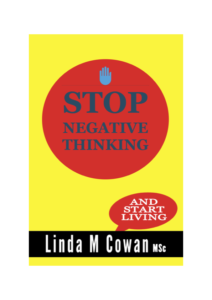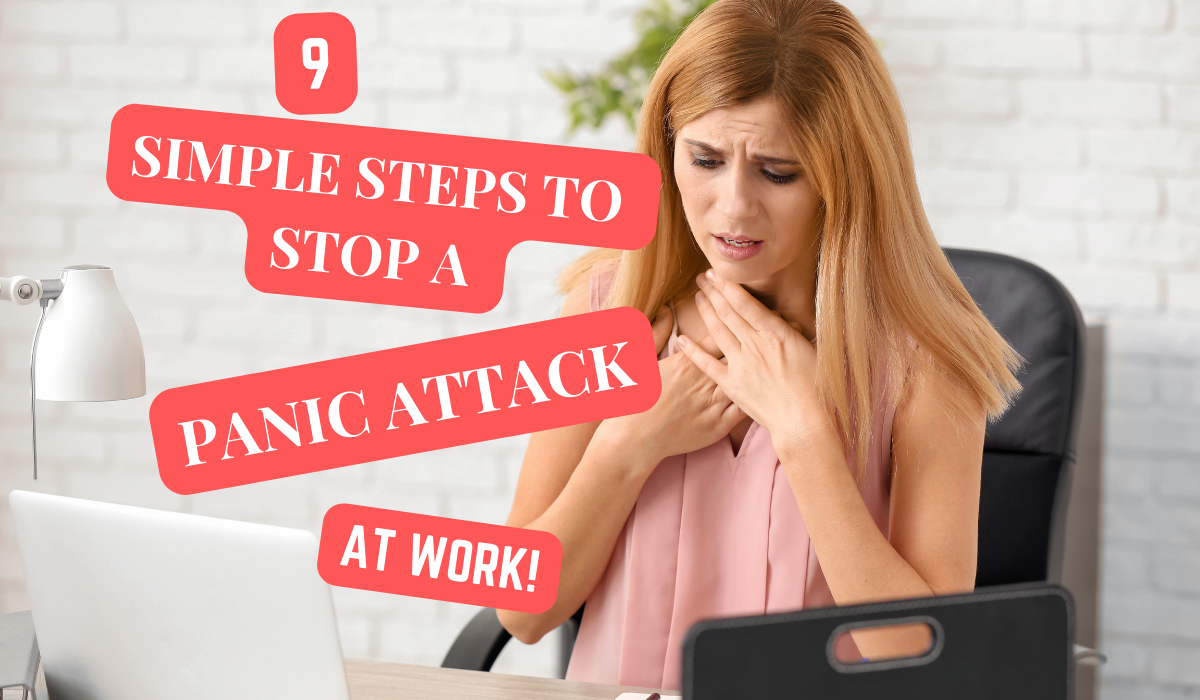

FREE EBOOK DOWNLOAD
To help with a panic attack at work, I am providing a FREE download of my ebook ‘How to Stop Overthinking.’ Just press on the link above.

INTRODUCTION – PANIC ATTACKS AT WORK
Over the years of working in private practice, I’ve encountered a surprising number of individuals who suffer from panic attacks at work. Notably, the teaching profession emerged as one of the most common sectors where stress-related issues, including panic attacks, are prevalent. While many might assume that the generous vacation time and seemingly shorter workdays in teaching would mitigate stress, the reality is quite the contrary.
Teachers face many challenges and demands that extend far beyond classroom teaching, from adhering to stringent educational standards to managing diverse student needs and navigating complex administrative requirements.
Similarly, professions such as social work, policing, and nursing are also recognised for their high-stress levels. These roles, characterised by intense emotional labour, unpredictable environments, and the constant need to make critical decisions under pressure, significantly contribute to the risk of experiencing panic attacks among professionals.
While this list is far from exhaustive, it underscores a broader issue: high-stress occupations, regardless of perceived benefits, carry inherent challenges that can profoundly impact mental health and well-being.
Maintaining a balance between productivity and mental health has become increasingly challenging in today’s fast-paced workplace environments. Unfortunately, panic attacks at work have become more and more common. Experiencing panic at work can be particularly distressing due to its sudden onset and the physical symptoms that accompany
Understanding panic attacks, recognising their signs, and knowing how to manage them are crucial steps in safeguarding both your mental health and your career.
This blog post aims to explore the intersection of panic attacks and the workplace, offering insights into the physical symptoms, the importance of support systems, and strategies for managing anxiety disorders at work. Join us as we delve into understanding panic attacks professionally and how individuals and businesses alike can foster a more supportive work environment for everyone. So first of all:
WHAT IS A PANIC ATTACK?
According to R.C. White (Harvard Business Review), quoted from the American Psychological Association (APA), a panic attack is “a sudden surge of overwhelming fear that comes without warning and any apparent reason.
It can occur unexpectedly or be triggered by specific situations. It is often described as feeling a loss of control or fear of impending doom, even when no real danger exists. Panic attacks are associated with panic disorder, but they can also occur in the context of other mental health conditions or without any disorder at all.
THE SYMPTOMS OF A PANIC ATTACK
According to Joe Pinda (Champion Health), panic attack symptoms cause all sorts of intense physical symptoms, such as shortness of breath, a tight chest, dizziness and nausea. However, other symptoms include sweating, trembling or shaking, feelings of choking, chills or heat sensations, Paraesthesia (numbness or tingling sensations. Derealisation (feelings of unreality) or depersonalisation {being detached from oneself), fear of losing control or(going crazy) and finally the fear of dying.
Panic attacks can be very frightening and disorienting, and the physical symptoms are often so severe that people may think they are having a heart attack or other life-threatening health issues.
TIPS ON HOW TO HELP AN EMPLOYEE EXPERIENCING A PANIC ATTACK AT WORK.
Supporting an employee during a panic attack at work requires a compassionate and thoughtful approach. Here are practical tips on how to help:
1. RECOGNISE THE SIGNS.
Understand the symptoms of a panic attack, such as rapid breathing, trembling, sweating, feelings of choking, or intense fear. Recognising these signs can help you respond appropriately.
2. OFFER IMMEDIATE SUPPORT
Stay Calm: Your calmness can help soothe the employee. Speak in a gentle, reassuring tone.
Find a Quiet Place: If possible, help the employee move to a quiet and private space to reduce stimuli and help them feel secure.
Be Present: Let them know you are there to support them without overwhelming them. Sometimes, just knowing someone is there can be comforting.
3. LISTEN WITHOUT JUDGEMENT
Encourage them to express their feelings if they wish to. Listen attentively and acknowledge their experience without minimising their feelings or offering unsolicited advice.
4. ENCOURAGE SLOW, DEEP BREATHING.
Suggest that they take slow, deep breaths. Breathing deeply and slowly can help counteract the hyperventilation that often accompanies a panic attack. You can even guide them through a breathing exercise if they seem receptive.
5. OFFER REASSURANCE.
Remind them that panic attacks, although frightening, are not life-threatening and will pass. Reassure them that they are in a safe place and you are there to support them.
6. AVOID MAKING ASSUMPTIONS.
Don’t assume you know what they need; ask how you can help. Avoid phrases like “You just need to relax,” which can be dismissive. Instead, ask, “How can I support you right now?”
7. FOLLOW UP AFTER THE PANIC ATTACK AT WORK.
After the panic attack has passed, check in with the employee to see how they are feeling. Discuss any adjustments or accommodations they might need in the short term to feel more comfortable returning to work.
8. ENCOURAGE PROFESSIONAL SUPPORT.
Gently suggest they seek help from a mental health professional if they are not already doing so. Offer information about your organisation’s relevant resources, such as an Employee Assistance Program (EAP). I would also recommend my Youtube video ‘Why I don’t have panic attacks anymore‘. to be useful to many people
By taking these steps, you can provide meaningful support to an employee experiencing a panic attack, contributing to a more supportive and inclusive workplace culture that recognises the importance of mental health.
HOW CAN ORGANISATIONS CREATE A MORE SUPPORTIVE ROLE FOR EVERYONE.
Organisations play a crucial role in shaping the work environment and can significantly influence the mental well-being of their employees. Creating a supportive workplace culture that actively reduces the stigma surrounding mental health issues involves a multifaceted approach. Here are several strategies organisations can adopt to foster a more supportive environment for everyone:
1. PROMOTE OPEN DIALOGUE
Encourage Open Communication: Foster an environment where employees feel safe to discuss mental health issues without fear of judgment or reprisal. This could include regular check-ins, mental health awareness sessions, and providing platforms for sharing experiences.
Educate Employees: Conduct workshops, seminars, and training sessions to educate employees about mental health, the importance of mental well-being, and the common misconceptions about mental health issues.
2. IMPLEMENT SUPPORTIVE POLICIES.
Flexible Working Arrangements: Offer flexible working hours, the option to work from home, or part-time work opportunities to help employees manage their work-life balance and reduce stress.
Access to Mental Health Resources: Provide employees with access to professional mental health support, such as counselling services or an Employee Assistance Program (EAP), at no cost.
Inclusive Health Benefits: Ensure the organisation’s health insurance plans cover mental health services, including therapy.
3. CREATIVE A HEALTHY WORK ENVIRONMENT
Promote Work-Life Balance: Encourage employees to take regular breaks, use their vacation time, and promote activities that support a healthy work-life balance.
Reduce Workload Pressure: Monitor workloads to ensure they are manageable and adjust expectations during high-stress periods or when an employee struggles.
Recognise and Reward: Acknowledge employees’ efforts regularly and create a culture of appreciation and positive reinforcement.
4. LEAD BY EXAMPLE
Leadership Training: Train leaders and managers on mental health awareness, supportive conversations with their teams, and leading by example in promoting mental well-being.
Normalise Mental Health Days: Encourage leaders to openly take mental health days and speak about the importance of mental health, setting a precedent for the rest of the organisation.
5. ESTABLISH A MENTAL HEALTH TASK FORCE
Create a Dedicated Team: Establish a task force or committee focused on mental health initiatives, responsible for creating policies, organising events, and being the point of contact for mental health resources.
Peer Support Networks: Develop peer support networks or mentoring programs where employees can offer and receive support from colleagues.
6. CONTINUOUS EVALUATION AND FEEDBACK
Regularly Assess Policies: Review and update policies and programs to meet employees’ needs and align with current mental health best practices.
Feedback Mechanisms: Implement mechanisms for anonymous feedback on the workplace’s mental health initiatives, ensuring continuous improvement based on employee input.
By adopting these strategies, organisations can create a more supportive environment that helps remove the stigma associated with mental health issues and contributes to their workforce’s overall well-being and productivity.
CONCLUSION – PANIC ATTACKS AT WORK.
In conclusion, workplace panic attacks are a multifaceted issue requiring attention and action from employees and organisations. For individuals experiencing panic attacks, the challenge is not only navigating the immediate physical and emotional turmoil but also managing the broader implications on their professional life and overall well-being. These individuals must recognise the signs, seek support, and employ strategies to cope with and, ideally, reduce the frequency and intensity of attacks.
From an organisational perspective, addressing panic attacks and mental health more broadly is essential for fostering a healthy, productive, and supportive workplace environment. Organisations have a vested interest in the well-being of their employees, as a workforce that feels supported in all aspects of their health is more engaged, loyal, and productive. By implementing supportive policies, promoting open dialogue about mental health, and providing access to resources, businesses can play a pivotal role in destigmatising mental health issues and empowering employees to thrive professionally and personally.
Ultimately, the issue of panic attacks at work underscores the broader need for a cultural shift towards greater empathy, understanding, and support for mental health in the workplace. By embracing a holistic approach that values mental well-being as much as physical health and professional achievement, both employees and organisations can work towards a future where panic attacks and other mental health challenges are met with compassion, support, and effective management strategies. This benefits individuals who are directly affected and contributes to creating a more inclusive, resilient, and productive workplace for everyone.





